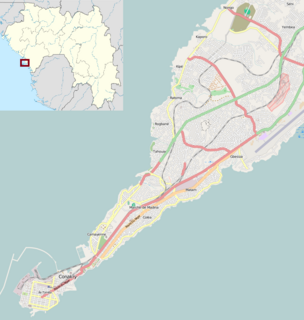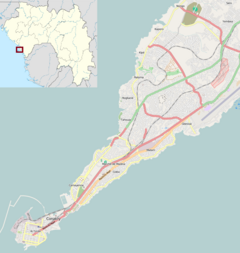
Guinea, officially the Republic of Guinea, is a west-coastal country in West Africa. Formerly known as French Guinea, the modern country is sometimes referred to as Guinea-Conakry to distinguish it from other countries with "Guinea" in the name and the eponymous region, such as Guinea-Bissau and Equatorial Guinea. Guinea has a population of 12.4 million and an area of 245,857 square kilometres (94,926 sq mi).

The Republic of Guinea Armed Forces are the armed forces of Guinea. They are responsible for the territorial security of Guinea's border and the defence of the country against external attack and aggression.

Conakry is the capital and largest city of Guinea. A port city, it serves as the economic, financial and cultural centre of Guinea. Its population as of the 2014 Guinea census was 1,660,973.

Ahmed Sékou Touré was a Guinean political leader and African statesman who became the first President of Guinea, serving from 1958 until his death in 1984. Touré was among the primary Guinean nationalists involved in gaining independence of the country from France.

Kankan is the largest city in Guinea in land area, and the third largest in population, with a population of 190,722 people as of 2014. The city is located in eastern Guinea about 345 miles east of the state capital Conakry.
Balla et ses Balladins was a dance-music orchestra formed in Conakry, Guinea in 1962 following the break-up of the Syli Orchestre National, Guinea's first state-sponsored group. Also called the Orchestre du Jardin de Guinée, after the "bar dancing" music venue in Conakry that still exists today, the group made a number of recordings for the state-owned Syliphone label and become one of the first modern dance musical groups in Guinea to use traditional musical instruments and fuse together traditional Guinean folk music with more modern influences.

Kabiné Komara was Prime Minister of Guinea from 30 December 2008 to 26 January 2010. Until the end of 2008 a director at the African Export-Import Bank in Cairo, Egypt, Komara was announced as the new Prime Minister in a government radio broadcast on 30 December.

Gamal Abdel Nasser University of Conakry, is the largest university in Guinea and located in Dixinn Commune, Conakry, the Guinean capital. The name is generally shortened to the University of Conakry.

Guinea has 1,086 km of railways. This includes 279 km at 1,435 mm gauge and 807 km at 1,000 mm gauge. The latter includes 662 km in common carrier service from Kankan to Conakry.
Football is the most popular sport in the country of Guinea. It is run by the Guinean Football Federation. The association administers the national football team, as well as the national league. It was founded in 1960 and affiliated with FIFA since 1962 and with the Confederation of African Football since 1963.

The Grand Hotel de L'Independance, formerly the Hotel de France, is a hotel in downtown Conakry, Guinea. The hotel was first opened in 1954 as the Hotel de France, with a modernistic design for the time. It was renamed the Grand Hotel de L'Independance when Guinea gained independence in 1958. The hotel was extensively renovated in 1996, operating under management by Novotel until 2013.

The Sandervalia National Museum is the national museum of Guinea, situated in the capital, Conakry. Most of the rooms are empty, but it contains a limited display of traditional objects from different regions of Guinea, as well as objects and statues from the colonial era. Various craft items are for sale.

The Ignace Deen Hospital is a hospital in Conakry, Guinea built during the colonial era. The hospital is situated next to the National Museum.

The Monument du 22 Novembre 1970 is a monument in Conakry, Guinea that celebrates the defeat of the attempted coup led by Portuguese troops in 1970, named Operation Green Sea.

The Hotel Palm Camayenne is a hotel in Conakry, Guinea. Set beside the sea, it is one of Conakry's most famous hotels.
The Guinea National Library is the national library of Guinea, located in the capital city of Conakry.
Three primary energy sources make up the energy mix in Guinea: fossil biomass, oil and hydropower. Biomass makes the largest contribution in primary energy consumption. It is locally produced, while Guinea imports all the petroleum products it needs. The potential for hydroelectric power generation is high, but largely untapped. Electricity is not available to a high percentage of Guineans, especially in rural areas, and service is intermittent, even in the capital city of Conakry.
The following is a timeline of the history of the city of Conakry, Guinea.













